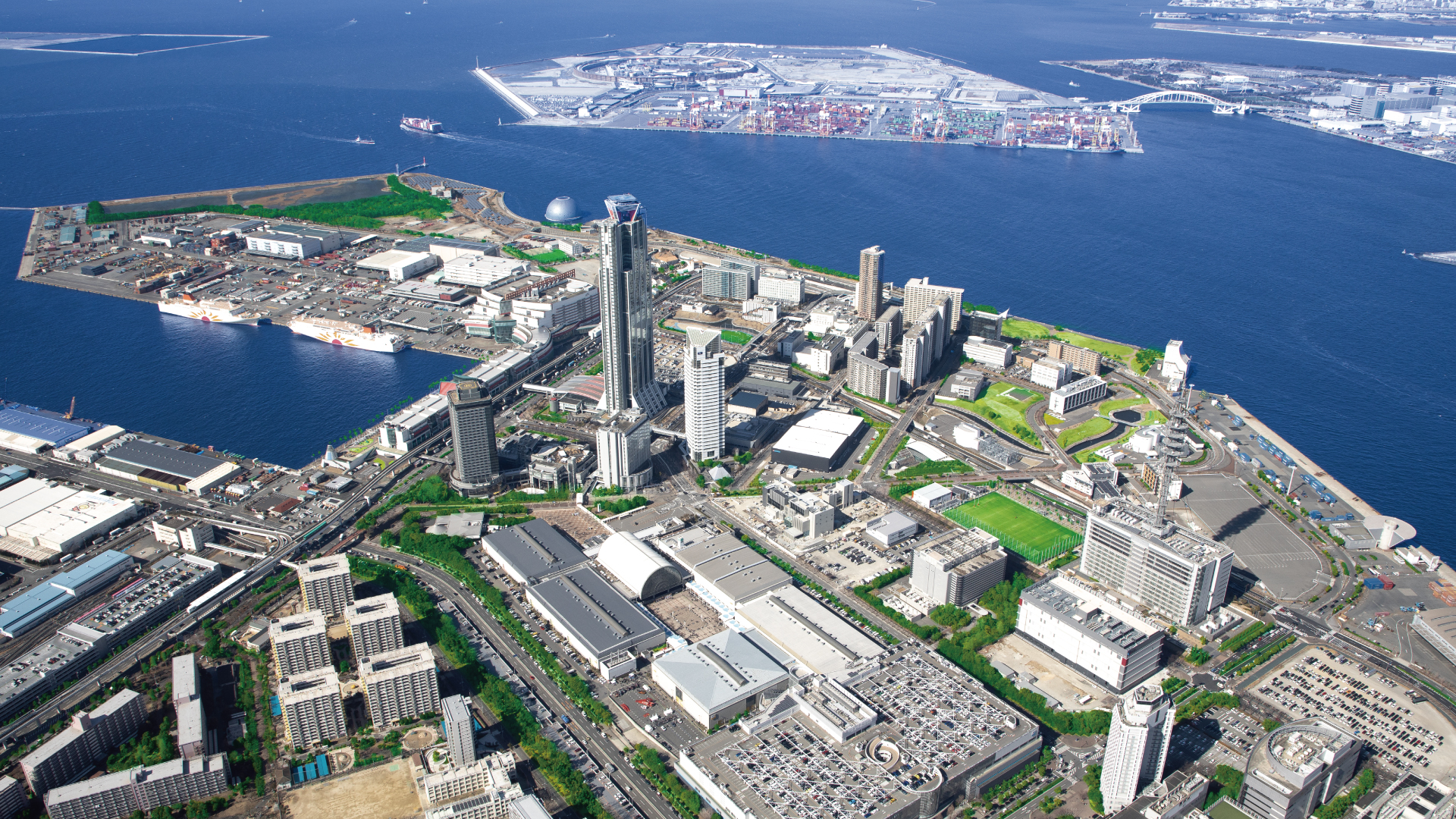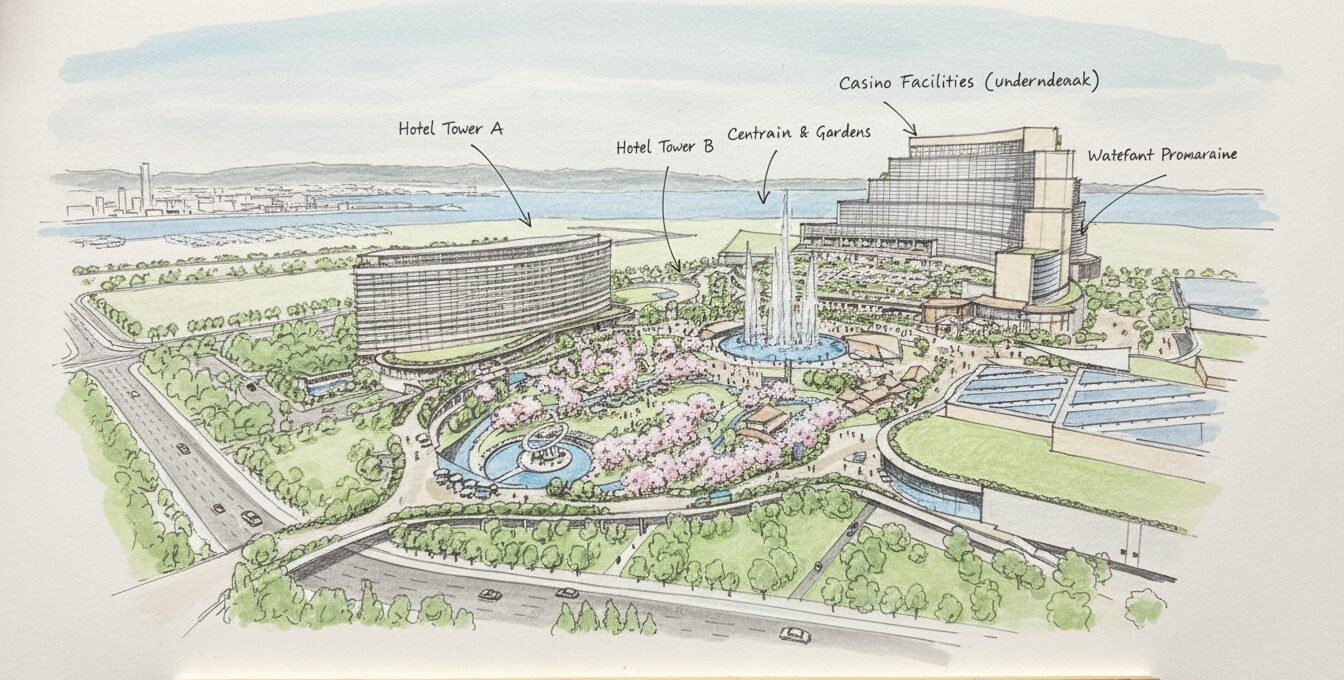
Osaka Bay is undergoing one of the most significant urban transformations in modern Japanese history. Once primarily known for logistics and manufacturing, this waterfront region has repositioned itself as a catalyst for regional economic growth through deliberate infrastructure investment, government support, and private-sector innovation. Learn more about Osaka's strategic development from official city sources.
The transformation centers on Yumeshima Island, a former underutilized artificial island that has become the focal point for development. The area's evolution demonstrates how strategic urban planning can revitalize neglected districts into vibrant economic centers.
The Japanese government implemented a comprehensive infrastructure development plan specifically designed to support Osaka Bay's emergence as a business destination. The most transformative improvement came with the extension of the Osaka Metro Chuo Line to Yumeshima Island, which opened in January 2025. This extension provides direct access from central Osaka to the bay area in just 30 minutes, fundamentally changing the area's accessibility.
Transportation enhancements extend beyond rail connections. The government completed a six-lane expansion of roads and bridges around Yumeshima, including the Konohana Bridge and intersection grade separation projects. These improvements ensure smooth traffic flow for both business commuters and commercial logistics operations. See infrastructure development details from MLIT.
The Port of Osaka serves as a Strategic International Container Port with direct connections to markets throughout western Japan. Yumeshima Container Terminal features three berths with a total wharf length of 1,350 meters, providing high-capacity logistics services that support businesses requiring distribution capabilities.
The Osaka-Kansai Expo 2025, which concluded in October 2025 after attracting over 28 million visitors, served as a powerful catalyst for infrastructure development that will benefit businesses for decades. The event generated an estimated economic impact of approximately 3 trillion yen and created lasting improvements to the area's transportation, utilities, and digital infrastructure.
| Cost Factor | Osaka Bay | Tokyo | Savings |
|---|---|---|---|
| Office Rent | 85% of Tokyo rates | 100% (baseline) | 15% savings |
| Residential Rent | 60-75% of Tokyo | 100% (baseline) | 25-40% savings |
| Average Commute | 39 minutes | 52 minutes | 4+ hours/week saved |
| Living Costs | 80-90% of Tokyo | 100% (baseline) | 10-20% savings |
| Water Bills | 3,100 yen/month | 4,000 yen/month | 900 yen/month |
The Expo required substantial investment in supporting infrastructure, including utility upgrades, digital connectivity improvements, and public space development that transformed Yumeshima from a remote logistics island into an accessible business location. These improvements remain as permanent assets available to companies establishing operations in the area.
More importantly, the Expo provided global visibility for Osaka Bay. Several companies that participated in Expo-related activities established offices at facilities like the ATC Building, recognizing the strategic advantages of the location. Learn about Osaka's growing startup ecosystem and business support infrastructure.
Perhaps the most transformative project for Osaka Bay's business ecosystem is the Osaka Integrated Resort, a massive $8.8 to $10 billion development scheduled to open in autumn 2030. Led by MGM Resorts International and Orix Corporation, this landmark project represents Japan's first legal casino resort and will fundamentally reshape the economic landscape of the entire region.
Construction officially began with a groundbreaking ceremony on April 24, 2025, marking the start of what will become one of the world's most expensive integrated resorts. The facility will occupy 492,000 square meters on the northern section of Yumeshima Island, adjacent to the former Expo site.
The Integrated Resort will feature an extraordinary range of facilities designed to attract both business and leisure visitors. The development includes 2,500 hotel rooms across three branded hotels—MGM Osaka, MGM Villas, and MUSUBI Hotel—providing accommodation options for different market segments. The resort will also include 330,000 square feet of exhibition space, 400,000 square feet of conference facilities, and a 3,500-seat theater for major events and performances.
A casino with extensive gaming facilities will occupy approximately 3 percent of the total indoor space, as mandated by Japanese law, but the resort's appeal extends far beyond gaming. The integrated design incorporates extensive dining options, retail outlets, spa and fitness centers, and a unique tourist-sending facility that will function as a large-scale tourism concierge promoting travel to Kyoto, Nara, and other destinations throughout the Kansai region.

The economic projections for the Integrated Resort are remarkable. The facility is expected to attract 20 million visitors annually, including 6 million international tourists. The construction phase alone is projected to generate approximately 1.91 trillion yen in economic impact, with an additional 1.14 trillion yen in annual impact after opening. Gross gaming revenue is estimated at approximately $5.9 billion per year, making it competitive with established integrated resorts in Macau and Singapore.
The resort anticipates an 80 percent domestic and 20 percent international visitor mix, capitalizing on the 20 million people residing in the Osaka metropolitan area. This visitor traffic will create sustained demand for supporting businesses, including office space, restaurants, transportation services, and professional services. Learn about IR opportunities and development at ATC and across the bay area.
For companies considering Osaka Bay relocation, the IR opening in 2030 represents not just a tourism milestone, but a catalyst for sustained business growth and employment. The timing creates a natural window for establishing office space now before prime locations fill.
28 million visitors, 3 trillion yen economic impact, infrastructure improvements completed
Direct 30-minute access from central Osaka to Yumeshima Island
MGM Osaka groundbreaking ceremony, $8.8-10B investment starts
Major innovation cluster north of Osaka Station, Umekita 2nd Project completion
2,500 hotel rooms, 20 million annual visitors, 1.14 trillion yen annual economic impact
Enhanced connectivity between Umeda and Namba, improved bay area access
50-hectare recreational area with race circuit, water park, multi-purpose arena
Osaka Bay's geographic position offers distinct competitive advantages that make it attractive for companies seeking a base in western Japan. The area sits at the heart of the Kansai region, Japan's second-largest economic zone, with a regional GDP comparable to countries like the Netherlands or Turkey.
From Osaka Bay, businesses enjoy convenient access to multiple major cities. Kyoto lies just 30 minutes away, offering access to traditional culture, tourism, and education sectors. Kobe is similarly 30 minutes from the bay area, providing connections to its port facilities and international business community. Nara remains easily accessible within the broader regional network.
This central positioning means companies based in Osaka Bay can serve customers, partners, and suppliers throughout the Kansai region without requiring multiple office locations. The proximity to diverse economic centers supports business development, recruitment, and market expansion strategies.
Kansai International Airport, located just 50 minutes from Osaka Bay, serves as a major international gateway crucial for companies with global operations. The airport recorded a record-breaking 9.46 million foreign visitors in the first half of 2024, surpassing pre-pandemic levels and demonstrating robust international connectivity.
Osaka has been designated as a "Global Startup City" by the Japanese government, reflecting its growing importance as an innovation hub. Key support organizations provide comprehensive assistance to growing companies. The Osaka Innovation Hub (OIH) operates as a city-backed startup community that hosts over 250 events annually, attracts diverse talent from around the world, and provides support for investment opportunities and collaboration with major firms.
Osaka has emerged as Japan's premier life sciences and biotechnology hub, with particularly strong clusters throughout the region. The area benefits from world-class research infrastructure, including Osaka University—one of Japan's top research institutions with 11 faculties, 15 graduate schools, and six research institutes. The university's Research Institute for Microbial Diseases leads in infectious disease and immunology research.
Three specialized life science hubs anchor the regional ecosystem. The Doshomachi area, situated on Midosuji Avenue, has been the center of Osaka's pharmaceutical industry for nearly 400 years, with major companies including Takeda, Shionogi, and Daiichi Sankyo tracing their origins to this historic district. Saito Life Science Park functions as a drug discovery and R&D hub, while Northern Osaka KENTO serves as a health and medical innovation hub with excellent transportation access.
The Osaka Bay area has positioned itself as a major destination for MICE (Meetings, Incentives, Conventions, and Exhibitions) events, creating sustained business demand for the area. INTEX Osaka operates as the largest exhibition venue in western Japan with 70,078 square meters of total exhibition space across 10 exhibition zones and 28 conference rooms. The facility hosts approximately 230 events per year and attracts 3 million visitors annually.
Professional office solutions in the bay area, such as ATC, offer flexible solutions designed for diverse business needs. The Asia and Pacific Trade Center operates a premier office complex with nearly 30 years of experience in property ownership and management, providing a proven track record that reduces risk for companies entering the market. The ATC complex is situated on Sakishima Island in Osaka Bay, approximately 5 kilometers from Osaka city center with direct Osaka Metro access via Trade Center-mae Station.
Office space at ATC ranges from approximately 67 to 373 square meters with flexible lease terms tailored to project needs. All offices come fully equipped with utilities and high-speed internet, featuring modern interiors with open layouts and customizable configurations. Tenants receive access to building amenities including cafes, restaurants, meeting rooms, and approximately 1,200 covered parking spaces for employees and visitors.
The development timeline for Osaka Bay extends well beyond the Integrated Resort opening, with multiple major projects scheduled through 2030 and into the following decade. This extended development pipeline ensures sustained construction activity, continued infrastructure investment, and expanding business opportunities for years to come.
Between 2025 and 2027, the full opening of Grand Green Osaka (Umekita 2nd Project) is scheduled for FY2027, creating a major innovation cluster north of Osaka Station. Continued development of Yumeshima post-Expo will repurpose facilities and land for permanent commercial and residential use. The 2028 to 2030 period will see the opening of the Osaka Integrated Resort in autumn 2030, further development of the bay area including potential additional hotels, entertainment venues, and business facilities, and completion of the Naniwa-suji Line (scheduled for 2031), dramatically improving access between Umeda and Namba.
Beyond 2030, plans include a 50-hectare recreational area with a race circuit, water park, hotel, and multi-purpose arena positioned to complement the Integrated Resort. The Kintetsu Group and other major transportation companies are developing long-term visions extending to 2035, specifically focused on expanding business through bay area development and capturing new demand created by the Integrated Resort and related attractions. This extended planning horizon reflects confidence in the area's sustained growth potential rather than viewing it as a short-term opportunity.
Osaka Bay's transformation from an industrial waterfront into a thriving business hub represents one of the most significant urban development success stories in contemporary Japan. The convergence of the Osaka-Kansai Expo 2025, the forthcoming $10 billion Osaka Integrated Resort, world-class life sciences infrastructure, a robust startup ecosystem, and strategic government support has created an environment uniquely positioned for business growth and innovation.
The region offers compelling advantages for companies evaluating Japanese expansion: operating costs 15 to 40 percent lower than Tokyo, excellent international connectivity through Kansai International Airport, strong research and academic institutions supporting innovation, a welcoming atmosphere for foreign businesses and residents, and significant infrastructure investments that will continue delivering value for decades. For businesses seeking to establish or expand operations in Japan, Osaka Bay presents an opportunity to position themselves at the forefront of a growing economic zone.

I’m a marketing/PR specialist at ATC in Osaka. I manage our website and newsroom, share leasing updates for ATC office spaces, and write about Osaka Bay growth, including the future IR Osaka project.
Explore the latest coworking space expansion, flexible office growth, and market dynamics shaping office real estate in Osaka for 2025 and beyond.
Browse flexible office solutions in Osaka Bay ranging from 67 to 373 square meters with customizable configurations and comprehensive building amenities.
Q: When will the Integrated Resort open?
A: Autumn 2030, bringing 20 million annual visitors and sustained business demand to the region.
Q: What's the commute time from ATC to Kansai Airport?
A: Approximately 50 minutes via direct limousine bus service or 40 minutes via rail with one transfer.
Q: Are there flexible lease options?
A: Yes. ATC offers lease terms from 1–2 years (project-based) to longer-term commitments based on business needs.
Ready to explore Osaka Bay for your business?
Call ATC: +81-6-6615-5002 or Get in Touch